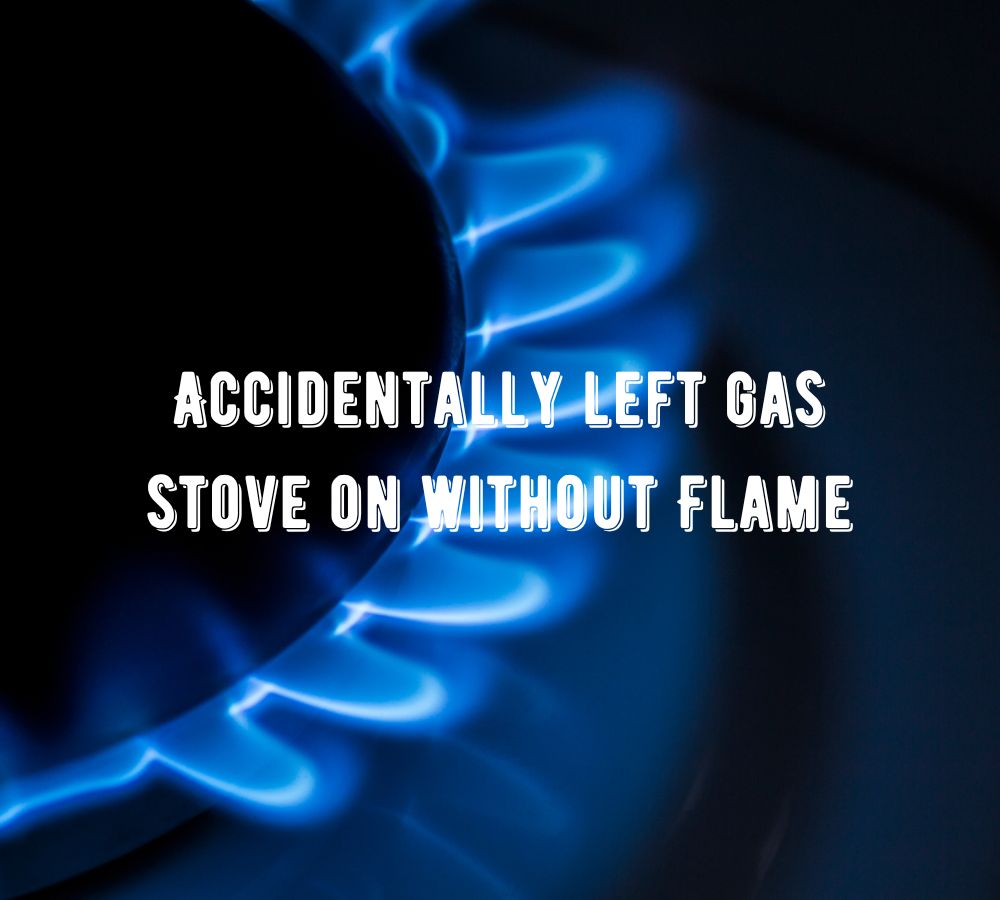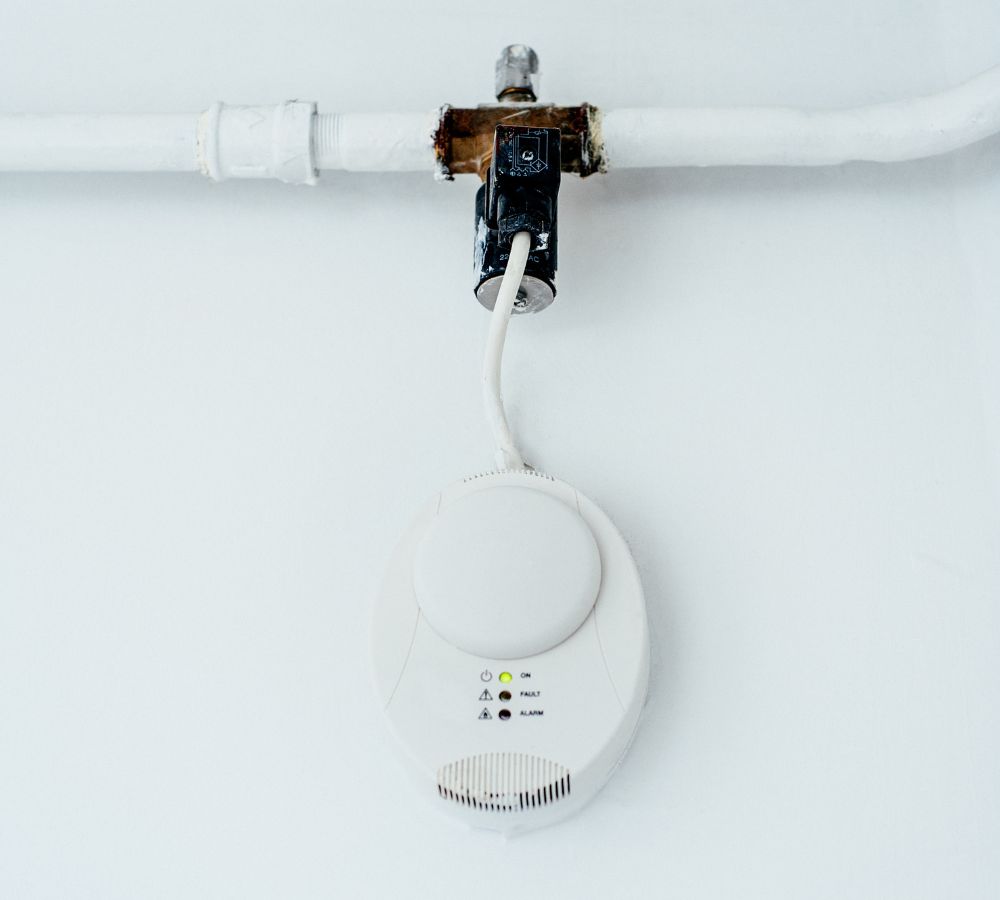Accidentally left gas stove on without Flame (How to Solve)

Accidentally left gas stove on without Flame. Whoops – we’ve all been there! You’re making dinner in a rush and leaving the gas stove on without a flame. We’ve got tips and tricks for what to do if you find yourself in this accidental (but all too common) predicament.
Table of Contents
What Happened?
Gas builds up in the area when a gas stove is left on without a flame. There are several potential consequences of leaving a gas stove on without a flame present. The most hazardous of these outcomes is an accumulation of unburned and poorly burned fuel, which can cause a build-up of carbon monoxide in an enclosed space.
Carbon monoxide is dangerous because it can leach into the air and cause health effects, including headaches, nausea, dizziness, confusion, loss of consciousness, and death. Furthermore, should any spark from another appliance, such as an electrical device or light switch, come into contact with this gas build-up, it could cause a fire or an explosion in your home that could be catastrophic.
Causes: Why it Happens

Accidentally leaving a gas stove on without Flame can happen for several reasons. The most common causes are leaving the knob in the wrong position, not hearing or detecting the familiar hissing sound of gas escaping, and forgetting to turn off the stove after cooking.
Gas stoves typically have two levers: one for lighting the Flame and another that controls how much gas is provided to the burner. When you turn on the gas, it flows through pipes from a container outside your home. Gas detectors in your kitchen usually trigger an alarm if there is any sudden increase in natural gas levels within your home. However, this alarm may only be activated when dangerously high levels are reached.
In addition, some stoves also feature an automatic shut-off element that will switch off the supply of gas if it detects a high level of fumes in your kitchen or if it senses that it has been left running for an extended period of time without being lit.
Other causes of accidentally leaving a gas stove on without Flame include:
- Obstruction or blockage of valves
- Loose and worn pipes or fittings
- Incorrect installation due to large piping bores
- Faulty ignitions can also prevent successful lighting, thus leading to forgotten stoves and possibly dangerous leakages.
Effects: What Resulted?
Depending on the time the gas stove was left on without Flame, there can be varying degrees and types of damage. Prolonged exposure to unburned natural gas, carbon monoxide, and other toxic combustion byproducts can result in shortness of breath, dizziness, and headaches, and in extreme cases, exposure to the gas can lead to an explosion.
Natural gas is a combination of methane and other hydrocarbons like ethane and butane. It is naturally odorless, however; chemicals are added to it that produces a skunk-like scent. The warning smell is what alerts people to potential dangers when it’s leaking out of electrical appliances or other sources.
You’ll want to keep an eye out for this odor if you suspect your gas stove was left on without Flame for any period of time. In addition to smelling the added scent of natural gas, excessive humidity or condensation may present themselves throughout your home after some time has passed. If your windows are steamed up from condensation, or you smell the pungent scent from natural gas, then it might be time to take action before further damage occurs.
Lastly, long-term invisible damage may have been done as well, such as corrosion and rusting due to excessive exposure to natural gasses, which could undermine a building’s structural integrity over time.
Prevention Methods: Avoiding Future Accidents
It is imperative to practice caution when handling open flames, as these can have serious consequences. Prevention methods are an important part of avoiding future accidents related to gas stove use. To reduce the risk of leaving a gas stove on without Flame, consider the following safety measures:
- Make sure you fuel your gas stove with appropriate fuel sources such as propane or natural gas. Never use lighter fluid or other combustible materials to fuel your stove.
- Check all connectors, valves, and pilot lights before use to ensure proper function.
- Always follow the directions included with your gas stove before operating it, as proper ventilation and other considerations must be considered.
- Before turning off the burner on a lit stove, be sure to wait until you hear audible clicking sounds indicating that the pilot light is extinguished and any further flame has been contained.
- Check for any lingering smoke or odors when you leave the room to ensure that nothing has been left burning unintentionally.
- If at any point you detect a strange odor from an appliance that could indicate problems such as leaks in seals or tank components, be sure to address these IMMEDIATELY and have them fixed by a licensed professional BEFORE using your appliance again.
Accidentally Left Gas Stove on Without Flame

When you leave your gas stove on without a flame and do not respond to the audible warning, it is considered an act of negligence. Accidents and mishaps occur for many reasons, but these mistakes can be prevented by following safety precautions.
- Never leave your gas stove unattended, even for a few minutes – if you need to step away or take a break, turn off the stove first.
- It is also important to check burner valves regularly to ensure they are firmly turned off.
- Additionally, be sure that all knobs are pushed in when not in use and never touch potentially HOT surfaces while operating the stove.
In addition to carefully monitoring your gas stoves, it is extremely important to always have functional carbon monoxide detectors in your kitchen or dining area. Carbon monoxide (CO) is odorless, tasteless, and extremely hazardous; without proper ventilation, CO builds up quickly with no immediate warning signs or symptoms of excessive levels.
Regular maintenance of smoke/carbon monoxide detectors will ultimately save us from severe consequences due to neglecting safety precautions around the gas stove. A malfunctioning detector could lead to a dangerous build-up of carbon dioxide – this can result in sickness and even death if left unnoticed for too long.
Safety Measures: When Flames are Involved
Safety measures are of the utmost importance when dealing with flames, especially when it comes to gas stoves. It is critical that anyone using a gas stove wears protective clothing and follows all safety guidelines, no matter how many times they have used the stove before.
When turning the stove on, ensure that it is in the “off” position first and take extra care to check it again after starting the Flame. Doing this prevents any unwanted burning from accidents or malfunctions from occurring.
It is also important to always leave a gas stove turned on with a Flame present, as this can create hazardous conditions for both property and people who interact with it. If you believe you left your stove on without a flame, immediately turn off the valve and open any outside windows or doors in order to help ventilate any lingering gas that may be present. After ventilating your workspace, contact your utility company for further help if needed.
The Dangers of Unattended Stoves

When left unattended, gas stoves can be hazardous. Whether you have accidentally left the stove running with no flame or forgotten to turn it off completely, this is a serious safety risk in the home.
Gas stoves can produce potentially dangerous amounts of Carbon Monoxide if they stay on longer than necessary and create incomplete combustion. In this process, partially burned gas is released into the air. While most stoves come equipped with a safety feature that shuts off automatically when no flame is detected, there are still many potential hazards associated with leaving it on for too long or even turning it up too high and risking ignition.
Additionally, not properly turning off the stove immediately after use can cause the appliance to overheat, which can lead to fires or even explosions. To keep your home safe from such dangers caused by unintentional mistakes, make sure to always turn your stove off correctly – close any gas valves and double-check if necessary – once you’re done cooking.
For extra security measures and peace of mind, consider investing in other appliances that use an electronic ignition system, such as induction cooktops that turn the burner on and off automatically when needed.
The danger of Left Gas Stove on Without Flame
When a stove is left lit and inoperable, it is important to take the following steps as soon as possible to avoid dangerous situations. Call your local fire department or emergency services if any of these steps take time to be completed.
- Turn off both the natural gas valve and the burner knob on the stove. Natural gas is odorless and colorless, making it difficult to tell when gas has reached a dangerous level in the room. It is critical that this step be accomplished first in order to prevent a potential explosion in the home.
- Open all available windows and doors to disperse any collected natural gas fumes remaining in your home. If ventilation is not possible, proceed cautiously below:
- If you do not hear or smell natural gas sounds or scents (rotten eggs or sulfur), turn on all exhaust fans (kitchen oven/range hoods) that are vented outdoors; fan blades may be used as an additional safety measure for ventilation for combustible gasses such as propane and butane. If either of these gasses is present, leave your home immediately, and contact your local fire department or emergency services for assistance.
- Check the temperature of walls near the stove’s burner with your hand – if they feel warm or hot -that may indicate that there could be high levels of combustion happening inside the wall itself- seek help from professional fireplace repair services like a chimney sweep as soon as possible.
- Install carbon monoxide detectors outside sleeping areas, near furnaces, and other appliances generating fumes; monitors should also be put where there isn’t great air movement, like storage rooms and laundry rooms – Fresh air circulation is needed for proper detector operation – replace batteries periodically it’s important you check them every month at least.
Gas Stove Safety Tips

Gas stoves are convenient for many households, but there are some safety precautions to keep in mind when using one. To avoid an accidental gas leak, follow these tips:
- Always make sure your cooktop is turned off fully, not just click on and off. This will ensure that fuel is not released into the air.
- When lighting a gas stove, always look at the burner before you ignite it to ensure there is no gas present.
- Never leave the Flame or gas valve open without ignition to avoid a potential fire hazard or build-up of carbon monoxide in your home.
- Always ensure all burners or other controls on your stove are set at the “off” position when it’s not in use.
- You may have accidentally left the stove on without Flame. Immediately open windows and doors and evacuate from the house to eliminate any risk of carbon monoxide poisoning.
Following these simple safety tips can minimize the risks associated with operating a gas stove.
Gas stove left on without Flame for several hours
If you have left a gas stove on without an open Flame present for several hours, it is important to take the necessary steps to ensure that your home is safe. In general, when you leave a gas stove for longer than 20 minutes without an open flame, there can be a risk of a build-up of carbon monoxide or other hazardous gasses in your home.
In the case of a gas stove left on for several hours, it’s best to ventilate the space as much as possible by opening doors and windows. Additionally, it would be best if you refrained from using any unprotected ventilation sources, such as fireplaces or clothes dryers, while ventilating the area. You should also call your local fire department if you notice any physical symptoms such as dizziness, headaches, or nausea that may be related to carbon monoxide poisoning.
Finally, ensure that a professional technician inspects your affected heating system and that all flues and vents are clear before using it again to prevent future safety concerns or emissions.
Accidentally left gas stove on without Flame overnight
Leaving a gas stove unattended can be extremely dangerous since it could release carbon monoxide into the home. Unvented gas appliances, such as ranges, ovens, and water heaters, produce carbon monoxide (CO), which is odorless, colorless, and toxic. Without adequate ventilation, the accumulation of CO can cause headaches, nausea, dizziness, confusion, and other symptoms of carbon monoxide poisoning. If there is too much CO in your home’s air, it is essential that you evacuate immediately.
Before re-entering your home after leaving the gas stove on overnight without a flame for an extended period of time, it is important to be safe and follow proper safety guidelines:
- Ventilate your home by opening windows or doors and running an exhaust fan for at least 1 hour;
- Have any heating appliances or other gas-powered devices inspected by a professional service technician before using them;
- Make sure you install at least one CO detector on every level of your home according to the manufacturer’s directions;
- Keep fuel-operated heating equipment properly adjusted;
- Do not burn charcoal indoors or in enclosed spaces;
- Read fuel container labels before refueling any appliance to avoid overfilling;
- Has your chimney been cleaned regularly to ensure proper ventilation?
Accidentally left gas stove on without Flame for a few minutes
If you have accidentally left the gas stove on without Flame for a few minutes, it is essential to take several safety precautions.
- Firstly, ensure all windows and doors are open to ensure proper ventilation. This will reduce the risk of carbon monoxide poisoning due to the incomplete combustion of natural gas.
- Secondly, locate the shut-off valve and turn off the gas supply until repairs can be made. Call a qualified technician to inspect your stove and adjust any components if necessary. In some cases, a faulty seal or another stove component may be causing an odorless leak which may need to be replaced to prevent future occurrences and continue using your gas appliance safely.
It is important to ensure that any repairs or adjustments needed are performed by a qualified professional who is experienced in working with gas appliances. Otherwise, serious injury or damage could occur due to improper use or installation. After all necessary inspections and repairs have been made, always practice extreme caution when using your gas stove, periodically checking for leaks or defective components before using it for cooking or heating purposes at home.
Accidentally left gas stove on without Flame all night
If you accidentally leave your gas stove on without a flame for a prolonged period of time, it is crucial that you take steps to ensure the safety of yourself and your household. Gas was leaking from the appliance, which could be combustible in the presence of an open flame. To protect yourself, first turn off all ignition sources, such as lighters, matches, and electrical switches. Then open all windows and doors to create ample ventilation and disperse any vapors quickly.
If you were not nearby when the incident occurred, there are several methods to check for any hazardous conditions upon returning home. First, look for any signs that may indicate a potential hazard, such as discolored walls, soot marks around screws or hinges, or scorch marks on shelves or cooking surfaces. Additionally, smell the air; any odors can indicate a potential danger due to flammable gas build-up in and around your appliances. Finally, use a carbon monoxide tester device (available at most hardware stores) to detect leaks in your home or apartment before entering or properly ventilating the area by airing out for about five minutes.
It is important that you take severe caution if an accidental leaving of a gas stove occurs – not only would it cause harm to someone in your home, but also it could create fire hazards which can lead to property damage and even fatalities if not taken seriously. If, after following these steps, worry persists regarding hazardous conditions from leaving the gas stove on without Flame overnight, contact local authorities as soon as possible who specializes in dealing with these sorts of situations safely and effectively.
How long does it take for the gas to air out?
When the gas stove is left on without the Flame, the gas will continue to expel from the burner into the air until it is manually shut off. The amount of time that it takes for the gas to dissipate from the room varies depending on factors such as ventilation, temperature, and humidity. In order to prevent carbon monoxide poisoning and other potential hazards, make sure you ventilate your kitchen area properly when leaving any gas appliance running.
It is important to note that just because you cannot see or smell a gas leak does not mean that one isn’t occurring. New ovens should always be turned on, and appliances like microwaves should be unplugged after use. And always follow manufacturer instructions when lighting or shutting off a pilot light.
Can you get carbon monoxide poisoning from a gas stove?
Yes, it is possible to get carbon monoxide poisoning from a gas stove, even if the Flame is not lit. Natural gas and propane stoves produce carbon monoxide when they burn. However, the levels of carbon monoxide produced by a lit burner are typically low enough that they do not pose a significant health hazard unless there are ventilation issues in the home.
When a stove is left on without being lit, gas can still enter the air and accumulate in confined spaces – such as homes with poor ventilation or areas where air does not circulate easily. Levels of carbon monoxide can increase dramatically in these spaces, leading to dangerous concentrations of the gas. If a person breathes this air for an extended period of time, it can lead to symptoms such as headache, nausea, confusion, and fatigue. It is also possible for people who are exposed to high levels of carbon monoxide over long periods of time to suffer from permanent brain damage or even death in extreme cases.
If you have accidentally left your stove on without Flame, it is best to leave your home immediately and call 911 for help. Suppose you determine that there isn’t an immediate hazard posed by breathing in elevated concentrations of carbon monoxide after returning home. In that case, you should take steps to improve ventilation throughout your house before further use of any natural gas or propane appliances – including your stove – such as:
- Ensuring all windows are opened efficiently.
- Exhaust fans are functioning properly.
Additionally, consider installing carbon monoxide detectors around natural gas appliances’ locations so that any future problems can be identified more quickly and avoided more easily.
Conclusion
In conclusion, accidentally leaving the gas stove on without a flame is a common mistake that can result in danger. Always double-check that all your stoves and burners are completely turned off after you have finished cooking. Do not hesitate to contact your local fire department for guidance if you leave the stove on. Additionally, installing carbon monoxide detectors in your home is beneficial to ensure the utmost safety.
If you left the gas stove on, you might smell gas in the area. Additionally, you may hear a hissing sound coming from the stove.
If you left the gas stove on without the Flame on, you should immediately turn off the gas at the source. Then, open the doors and windows for ventilation. You should also call your gas company or a qualified technician to inspect the area and make sure there is no gas leakage.
Yes, if you leave the gas stove on without the Flame, there is a danger. Gas can accumulate and create an explosive situation. Additionally, the gas can be harmful to your health if inhaled.


